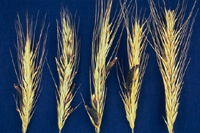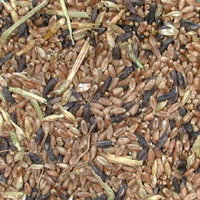Plant diseases impact our daily lives in many ways. Yield losses are a direct effect of plant disease that farmers and producers face every year, but could the effects of plant disease reach far beyond this? Can a plant disease affect our health? Would you believe a plant disease could have caused the deaths of thousands during the Middle Ages or incited the Salem witch trials? How could a plant disease contribute to the French Revolution? Was Peter the Great halted in his efforts to capture a warm water port at Constantinople (Istanbul) by a plant disease?
Ergot of rye, caused by Claviceps purpurea (an ascomycete fungus), is the plant disease interacting with humanity in the historical events mentioned above. C. purpurea infects the ovary of rye (or other cereal grains) while the plant is blooming. The fungus colonizes the ovary and begins to replace the plant tissue with hard black structures called sclerotia (Figs. 1 and 2.). In the field, some of the sclerotia drop to the ground as the grain ripens and function as a winter survival mechanism for the fungus. During the following spring, sclerotia produce tiny stalks called stromata (Fig. 3). In the stromata, perithecia form and produce ascospores (a type of sexual spore produced in an ascus or sac). These ascospores are disseminated by wind, infect flowers of new rye plants, and initiate the disease cycle again. However, the problems with ergot for humans and animals begin when the grain is harvested for use in flour and feed. Ergot sclerotia are unintentionally harvested along with the grain. If these sclerotia are not removed, they will be ground into flour along with the grain. Toxic alkaloids contained in the sclerotia are distributed throughout the flour during grinding. Baking does not destroy the ergot alkaloids. When people eat bread or baked goods made with flour containing ergot, they also consume the alkaloids and can develop the symptoms of ergotism. Symptoms of ergotism include: hallucinations, burning or crawling sensations under the skin, miscarriage, gangrene, loss of limbs, and death. Animals are affected by ergotism when they consume grain or hay containing ergot sclerotia.

Figure 1 |
|

Figure 2 |
|

Figure 3 |
Today, ergot is controlled by crop rotation, sound management practices, grain standards in rye and wheat, and milling standards. However, ergot and endophytic fungi related to ergot remain disease problems that require careful management as localized outbreaks of ergotism (primarily in livestock) continue to be recorded.
For more information on ergot of rye, try these sources:
Suggestions for Multidisciplinary
Coordinated Units on Ergot
Agriculture
- Crop losses due to ergot
- Management and control of ergot
- Use of other endophytic fungi to improve pasture grasses
- Ergotism and other alkaloid toxicities in livestock
Art
- Heironymous Bosch and images of ergotism
- Influence of ergotism on Medieval art
Biology
- Life cycle of Claviceps purpurea
- Ascomycete fungi
- Anatomy of monocot flowers
Consumer and Food Sciences
- Ergot alkaloids and other toxins that are transmitted by food
- Role of milling and baking standards in controlling public health
Health
- Symptoms and effects of ergotism
- Human circulatory system
- Medications developed from ergot alkaloids
History
- Ergotism and St. Anthony's Fire in the Middle Ages
- Salem witch trials
- Influence of ergot on the French Revolution
- Peter the Great and his march toward Constantinople
|
